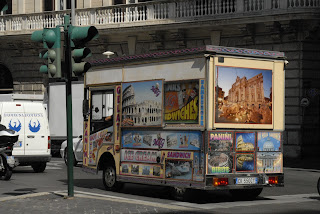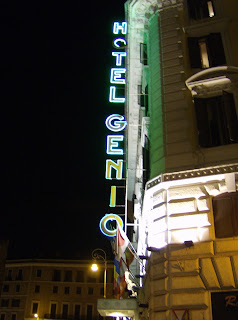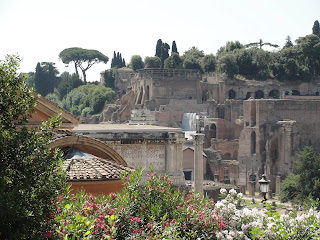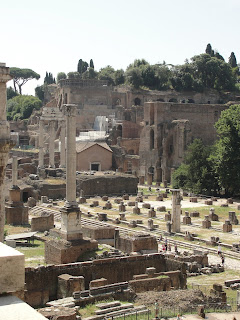As a rule, no new construction has occurred in Rome since WWII. Prior to WWII, all new construction was created on the foundation of other construction. Several of the ancient structures are underground and still undiscovered or new buildings are built around them if they have been excavated.
As the city rose in elevation due to progression and the tide, existing buildings simply added new floors to match the architecture of the time. Churches, for example, offer the opportunity to view 2,000 years of construction simply by descending three flights of stairs through the building(s).
A good example can be see from the patio of our hotel.
Just a few feet to the left of the picture below is Piazza Navona where Stadio Di Domiziano once stood. Today, contained on a lower level of the existing building, is a portion of the structure that still remains of the 30,000 seat colosseum. The left portion of the photo is better outlined in the next photo. The Tor Sanguigna tower that was built ~1100 A.D was often home to executions. Now, it is simply the corner anchor of the existing building. History surrounds us in Rome, but we need to know what to look for.
Portions of the Pantheon are underground as well. The wall on the right is close to twenty feet high and it surrounds the whole structure except for the main entrance, which has never been compromised due to new construction.
As we walked toward the area of the Roman Forum (Not the Forum Shops of Las Vegas) and the Colloseum (Not where Elton John tickles the keys of the red piano), we ran across several areas that were dug out to reveal the ruins of yester-millenia (I just coined that term myself).
This site above was still being excavated.
To get to the heart of the Roman Forum, history needs to be experienced in reverse by passing the newest buildings first as the city expanded outward and in this case when the country was united.
The Altare della Patria aka Monumento Nazionale a Vittorio Emmanuel II was constructed for the first King of unified Italy. It was completed in 1925 after 40 years of planning and construction. An elevator was added in 2007 that allows for fantastic views from the top.
Right next door is Piazza Venezia, which was one of the main meeting squares\parks of ancient Rome. It is still a main intersection of travel in Rome.
It is time to mention the public transit system in Rome, because this intersection is now a key player in the progression of public transit.
Rome has two main subway lines. One more or less runs East and West while the other one runs more or less North and South.
Rome has decided to build a third subway line and I think their estimation of completion is far too low. The further down that they dig, the more artifacts that they uncover and the further toward the forum that they dig, the more artifacts that they uncover. Each time that they unearth something, it needs to be excavated and logged before the construction\tunneling can continue. Due to these constant delays, I have a feeling that I will never ride Line C in Rome.
Just 18 ft. underneath Piazza Venezia and very early in the launch of the Line C project, they have run into what they are calling an "Ancient Arts Center." Three rooms from the era of Emperor Hadrian in the 2nd century that range from a 900 seat auditorium to a coin mint.
Just past the Monumento Nazionale a Vittorio Emmanuel II, the landscape starts to change and age. Centuries of mineral deposits on this fountain begin to tell the story.

Next door to the Monumento Nazionale a Vittorio Emmanuel II on the tallest hill of Capitoline Hill is the Basilica of St. Mary of the Altar of Heaven. A medieval church that was completed in the 12th century. We didn't make it inside on this trip, but I hope to return because I hear that it is beautiful. The second picture shows our next stop in the background. The Piazza del Campidoglio.
Piazza del Campidoglio of Capitoline Hill in it's current state, was designed by Michelangelo in the mid 16th century. To create balance and symmetry in the design, one of the buildings is a faux front of a building that is built on the backside of a Forum building. The faux 3rd building is used simply to frame the square on three sides.
We are getting close to the Forum.
In the piazza stands the statue of one of the greatest emperors of Rome... Marcus Aurelius, which was erected in 175 AD.
The statue below indicates that we are getting deeper into the origin of Roman history. The statue below is a mythological representation of how Rome began. Two brothers, Romulus and Remus, who were saved from death and raised by a she-wolf until they were the leaders of Rome.I among others question the validity of this portion of the story, but the rest sounds a little more realistic. In true emperor fashion, whenever there were co-rulers, one seemed to always die suddenly and these brothers we no different. Romulus killed Remus and named the Palatine Hill area of Rome after himself.
The original settlers of Rome were predominantly male, so the civilization lacked women. Romulus had an easy solution... raid nearby Sabine and seize all of their women. The Sabine men didn't take too kindly to this and wars broke out. And this is how it all started. Rome discovered that if you don't have a particular resource that you want or need, take it from someone who does have it. The raid on the Sabine is depicted in artwork throughout Roma and Firenze.
Rome is the city of seven hills and the last two ascents have caused the need to rest before we descend into the Forum.
It's not everyday that you can use an ancient column as a stool to rest upon. The hill also offered an opportunity to look out over Rome and the areas that we were about to explore.





The following is all that remains of the Temple of Venus (Tempo di Venere Genitrice), which was constructed by the one and only Julius Caesar in 46 BC!
A little past the temple is the Santi Luca e Martina, which was built in 625 AD.
In the heart of the original empire that is Pallatine Hill is a great... wait... the only opportunity in the world that I know of that by simply turning around and taking a quick look behind us reveals 2,000 years of history!

Some of structures are obvious and easily dated, but others will never be agreed upon and some are merely a few feet underground in this site that wasn't unearthed until the 1920s. Building after building built on top of one another for over 2,000 years. The picture below shows countless eras of architecture all in one photo!

Deeper yet we go. We are nearing the center of "civilized" domination. If you weren't Roman, you weren't civilized. The Arch of Septimius commemorates the victories of Septimius over the Parthians in the very late 2nd century.
Nationalism at it's finest. How could you not rally around a nation that could build civilizations of astounding magnitude with as little as four pounds of pressure from a human being (more on this later).
The columns were often sculpted in other lands like Egypt and brought to Rome by boat in one piece.Siamo Qui! Il Colosseo.
Sorry Egypt. The Romans were able to move a large rock without the help of aliens and 10,000 men per rock. They could lift rocks the size of cars with only 4 pounds of pressure thanks to engineering.
Every time you add a pulley to a system, you decrease the force needed to move the object, you simply add to the amount of rope that is required to travel through the pulleys.
To make up for this they added the wheel shown below. A lot of torque on a small axis of the wheel made for large amounts a rope to be moved on the outer edge of the wheel through the pulleys.
The aliens quickly packed up their stuff and moved back to Egypt, but there was little work that needed to be done in Egypt by the time that they returned.

The small black holes in the rock are where the pulleys would latch onto the rocks.
Our Roma Pass got us past the long lines and gave us free admission to the Collosseum.
One of the neat things about this whole area is that they commonly placed ruins in accessable areas, so tourists could touch, walk, or sit on the ruins rather than looking past gates or rails.
The gladiators are very progressive nowadays. They were commonly seen taking pictures, checking the soccer scores on their phones and chatting with tourists rather than conquering the nearby Sabine.
It may be 90 degrees, but the weeds still need to be whacked!
A few vices along with some 16th century architecture.
Frankie says, "Relax" as he waits for the train to arrive at Il Colosseo.
Now... I am pretty quick with the camera, but I was just a little slow on this one, so you will just have to trust me. This was a nun coming out of a bar and she was REALLY moving!
Another shout out to local and national law enforcement and other vehicles!
Again, it has been hot in Rome this week and this has been a LONG day of walking, so we stopped for a Coke.
Like I said before, Italian Coke is phenomenal and yes, there are different kinds of Coke per country.



Ruh, roh, raggy. Smart car dumbed down a bit.
I am not quite sure what happened here. Maybe someone just told Davin that we have to walk back to the hotel as well. Or maybe he is hungry. Either way, Kel grabbed some gelato
Time for lunch.Let me repeat that... Lunch.
This story will be told for many years and it will be different depending on who tells the story.
I will patch it together from several views.
We started looking for a place to eat lunch and there aren't very many places around the colosseum to eat. If you need a Pope bobblehead, well you are covered (Kel bought two), but lunch is a different story.
We stopped at one place, looked at the menu and then moved on.
We approached Gran Caffe Rossi Martini Roma and I asked for a table for four and if we could sit outside. The hostess told me that my Italian was "Excellent." So far, the story is undisputed, the rest of the story lies with the person telling it.
Upon sitting down, I don't recall who ordered the wine. I don't recall reading a menu, although there was one posted on the window of the shop and one on the handrail by the street. Evidently we took a picture of the menu, but no one ever read it.
I speculate that Davin ordered the wine without asking about the price. Again, I don't think we looked at a wine list or asked for a price. Judging by the look on the servers face, this was an expensive bottle of wine!
I will take the blame for the next part. I ordered the appetizer. The server said that they had a grande pesce appetizer with langostinos, etc.
I agreed and I didn't ask for the price either.
According to their menu on the website, this 4 ft. long appetizer was about $175. Those spoons were about 14 inches long!

It took us awhile to eat this feast and playing with our food has now become a ritual at each meal.
Well, we have our Acqua Panna and our white wine, let's get some Ostrica.
And then the meals arrived.
And then either dehydration or inebriation set in as we played with the characters that made up our meal once again.
Il conto, per favore. The bill, please.
The bill arrived and it was not itemized. We probably should have asked for an itemized bill.
We could argue that it was a tourist trap.
We could argue that we were robbed.
We could argue that it was a high end ristorante\cigar bar, etc. because they did serve Louix XIII.
Either way that you want to go with it, our LUNCH FOR FOUR, just totaled $750!
It makes for a good story that I am sure that we will laugh and argue about for years.
We walked back to the hotel. The women insisted on walking (stumbling) down the middle of the street despite our advice to refrain from this activity.
After hitting the hotel to clean up and relax, we hit Piazza Navona for dinner, souvenirs, and more gelato.
Dehydration and inebriation would soon take over once again.
Time for bed.


Go to 6/24/11

















































































No comments:
Post a Comment